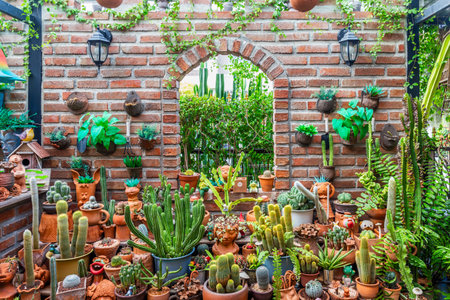Introduction to Xeriscaping
Xeriscaping is an innovative landscaping approach that emphasizes water efficiency by utilizing drought-tolerant plants, strategic soil management, and thoughtful garden design. As climate patterns shift and water scarcity becomes a growing concern across many regions of the United States, xeriscaping offers American homeowners a practical solution to conserve water while maintaining attractive outdoor spaces. This method not only helps reduce irrigation needs but also cuts down on maintenance time and utility costs—two critical factors as communities grapple with recurring droughts and rising expenses. By understanding the core principles of xeriscaping, beginners can make informed decisions that benefit both their property and the environment, setting the stage for a sustainable and resilient landscape.
Choosing the Wrong Plants
One of the most common mistakes beginners make when starting a xeriscaping project is selecting the wrong plants for their landscape. While it may be tempting to choose plants based on appearance alone, successful xeriscaping in the United States heavily depends on using native and drought-tolerant species that are well-adapted to specific regional climate zones. Ignoring this crucial step can result in higher water usage, increased maintenance, and plant failure.
Common Pitfalls in Plant Selection
- Overlooking Climate Compatibility: Many homeowners purchase attractive plants without considering whether they are suitable for their local USDA hardiness zone or rainfall patterns.
- Selecting Non-Native Species: Non-native or exotic plants often require more water, fertilizer, and pest control than native alternatives.
- Focusing on Aesthetics Over Function: Choosing plants solely for their looks rather than their drought tolerance can undermine the entire purpose of xeriscaping.
The Importance of Native and Drought-Tolerant Species
Native plants have evolved to thrive in local conditions, making them naturally resilient to drought and reducing the need for supplemental irrigation. Similarly, drought-tolerant species—whether native or well-adapted non-natives—require significantly less water than traditional turfgrass or thirsty ornamentals. Incorporating these types of plants not only conserves water but also supports local wildlife and reduces maintenance requirements.
Recommended Plant Types by U.S. Climate Zone
| USDA Zone | Region Example | Recommended Native/Drought-Tolerant Plants |
|---|---|---|
| Zone 3-5 | Northern Midwest, Rockies | Purple Coneflower (Echinacea purpurea), Prairie Dropseed (Sporobolus heterolepis), Serviceberry (Amelanchier spp.) |
| Zone 6-7 | Northeast, Mid-Atlantic | Black-eyed Susan (Rudbeckia hirta), Switchgrass (Panicum virgatum), Butterfly Weed (Asclepias tuberosa) |
| Zone 8-9 | Southeast, Texas | Lantana (Lantana camara), Gulf Muhly Grass (Muhlenbergia capillaris), Yaupon Holly (Ilex vomitoria) |
| Zone 10+ | Southwest, Southern California | Desert Marigold (Baileya multiradiata), Red Yucca (Hesperaloe parviflora), Palo Verde (Parkinsonia spp.) |
Expert Tip:
Always consult your local extension office or native plant society for region-specific recommendations before making any final plant selections. Investing time in research up front will save water, money, and frustration down the line.

3. Improper Soil Preparation
One of the most common pitfalls for beginners in xeriscaping is improper soil preparation. Many assume that simply adding commercial soil amendments or compost will create the perfect environment for drought-tolerant plants. However, this one-size-fits-all approach often leads to poor results. In reality, successful xeriscaping starts with a thorough understanding of your local soil profile. Across the United States, soil conditions vary dramatically—from sandy soils in the Southwest to heavy clay in parts of the Midwest and East Coast. Without first testing your native soil’s composition and drainage characteristics, you risk over-amending and disrupting the natural balance. Over-reliance on organic matter or peat moss can actually impede drainage, suffocate roots, or create a nutrient imbalance that stresses water-wise plants.
Understanding Your Local Soil
Before you break ground, invest time in a simple soil test—either with an at-home kit or through your local county extension office. This will reveal key information like pH, texture (sand, silt, clay), and nutrient levels. Armed with these details, you can make informed decisions about which amendments are truly necessary—or if your soil is already suitable for many xeric species native to your region.
Drainage Is Critical
Poor drainage is a leading cause of plant failure in xeriscapes. To test drainage, dig a hole about 12 inches deep and fill it with water. If it drains within a few hours, you’re in good shape; if not, consider incorporating inorganic materials like crushed granite or expanded shale to improve porosity rather than just adding compost.
Match Plants to Soil Types
Finally, select plant species that naturally thrive in conditions similar to your existing soil type. Native plants have evolved to handle local challenges without excessive amendment. Remember: xeriscaping succeeds when you work with nature rather than against it.
4. Inefficient Irrigation Systems
One of the most common mistakes beginners make with xeriscaping is setting up inefficient irrigation systems. Xeriscaping is all about conserving water, but improper watering practices can quickly undermine your efforts. Below, we’ll break down frequent errors and provide practical solutions to help you maximize water savings.
Common Irrigation Mistakes
| Mistake | Impact | Water-Saving Alternative |
|---|---|---|
| Overwatering | Wastes water, encourages shallow root growth, and promotes weed growth. | Water only as needed; use moisture sensors or check soil before irrigating. |
| Poor System Design | Uneven coverage leads to dry spots or oversaturated areas. | Design zones based on plant needs and sun exposure; avoid overlapping spray patterns. |
| Not Using Drip Irrigation | Spray systems lose water to evaporation and runoff. | Install drip irrigation for direct-to-root delivery, reducing waste by up to 50%. |
Focus on Drip Irrigation
Avoiding traditional overhead sprinklers in favor of drip irrigation is key for successful xeriscaping. Drip systems deliver water directly to the base of each plant, minimizing evaporation and runoff—crucial factors in arid American climates such as the Southwest. Additionally, using pressure regulators and filters will ensure consistent flow and prevent clogging from debris or mineral buildup.
Tuning Your Water Schedule
Xeriscaped landscapes thrive with less frequent but deeper watering sessions. By encouraging roots to grow deeper, plants become more drought-resistant. Consider watering early in the morning to reduce evaporation losses. Smart controllers that adjust schedules based on real-time weather data are also excellent investments for U.S. homeowners looking to optimize water use efficiently.
Key Takeaways:
- Audit your current irrigation setup annually for leaks and inefficiencies.
- Group plants by water needs to simplify zone management.
- Always prioritize drip irrigation for new installations.
By avoiding these common irrigation pitfalls, beginners can ensure their xeriscape remains both beautiful and sustainable while keeping water bills under control—a win-win for your landscape and the environment.
5. Neglecting Mulch and Ground Cover
One of the most common mistakes beginners make with xeriscaping is overlooking the importance of mulch and ground cover. These two elements play a crucial role in creating a successful, low-water landscape that’s both practical and visually appealing.
The Functionality of Mulch
Mulch acts as a protective layer over your soil, significantly reducing water evaporation. In America’s hotter and drier regions, this can mean the difference between lush plantings and parched landscapes. Organic mulches such as wood chips, shredded bark, or compost not only lock in soil moisture but also regulate temperature extremes and gradually enrich the soil as they decompose.
Weed Suppression
Another technical advantage of mulch is its ability to suppress weed growth. By blocking sunlight from reaching weed seeds, mulch minimizes competition for water and nutrients—both critical resources in xeriscaping systems. This reduces maintenance time and ensures that your chosen drought-tolerant plants thrive without unnecessary stress.
Boosting Curb Appeal
Beyond functionality, mulch and ground covers add texture, color, and cohesion to your landscape design. American homeowners often select decorative gravels or native ground covers such as creeping thyme or buffalo grass to create visual interest while maintaining water efficiency. These choices are not just aesthetic; they further help stabilize soil and prevent erosion during heavy rains or irrigation cycles.
Best Practices
For optimal results, apply a 2-4 inch layer of mulch around plants, keeping it a few inches away from stems to prevent rot. Choose ground covers compatible with your local climate and soil conditions for lasting success. By integrating these elements thoughtfully, you’ll avoid one of the biggest beginner pitfalls and maximize the resilience and beauty of your xeriscape.
6. Ignoring Maintenance Needs
One of the biggest misconceptions about xeriscaping is that it’s completely maintenance-free. While xeriscapes are designed to reduce water usage and require less upkeep than traditional lawns, they still need regular attention to thrive—especially in diverse U.S. climates. Ignoring essential maintenance can result in overgrown plants, weed infestations, and diminished curb appeal.
Regular Pruning Keeps Plants Healthy
Pruning is vital for shaping your landscape, removing dead growth, and preventing diseases from spreading among drought-tolerant species. Each plant has its own ideal pruning schedule; for example, many native grasses benefit from a spring cutback while flowering perennials may need deadheading throughout their blooming season. Staying on top of these tasks ensures your xeriscape looks intentional rather than neglected.
Debris Removal Prevents Pest Problems
Even in low-water gardens, fallen leaves, twigs, and organic debris accumulate. If left unchecked, this material can harbor pests like ants or termites and foster fungal diseases. Make it a habit to clear away debris periodically—especially after storms or windy days common in many American regions—to keep your landscape healthy and visually appealing.
Seasonal Adjustments Matter
Every region in the U.S. has its own climate quirks, from summer droughts in the Southwest to chilly winters in the Midwest. Seasonal adjustments are necessary for optimal plant health: update mulch layers to insulate roots during temperature swings, check irrigation emitters for clogs or leaks as seasons change, and replace any struggling plants with better-adapted varieties as needed.
By acknowledging that xeriscaping still involves periodic care—just different tasks than a traditional lawn—you’ll set realistic expectations and enjoy a thriving, sustainable yard year-round.


